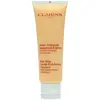What's inside
What's inside
 Key Ingredients
Key Ingredients

 Benefits
Benefits

 Concerns
Concerns

 Ingredients Side-by-side
Ingredients Side-by-side

Water
Skin ConditioningSodium Laureth Sulfate
CleansingCetearyl Alcohol
EmollientCellulose
AbsorbentCocamidopropyl Betaine
CleansingLauramide Mipa
Glycol Distearate
EmollientCetearyl Glucoside
EmulsifyingGlycerin
HumectantAcrylates/C10-30 Alkyl Acrylate Crosspolymer
Emulsion StabilisingTea-Cocoyl Glutamate
CleansingCitrus Aurantium Dulcis Fruit Water
MaskingSilica
AbrasivePersea Gratissima Fruit Butter
EmollientParfum
MaskingPhenoxyisopropanol
PreservativeSodium Chloride
MaskingPropylene Glycol
HumectantSodium Hydroxide
BufferingBenzophenone-2
MaskingButylparaben
MaskingDisodium EDTA
Methylchloroisothiazolinone
PreservativeMoringa Oleifera Seed Extract
Skin ConditioningMethylisothiazolinone
PreservativeChlorphenesin
AntimicrobialEthylparaben
PreservativeMethylparaben
PreservativeBHT
AntioxidantBenzyl Salicylate
PerfumingButylphenyl Methylpropional
PerfumingLimonene
PerfumingLinalool
PerfumingGeraniol
PerfumingCI 15985
Cosmetic ColorantWater, Sodium Laureth Sulfate, Cetearyl Alcohol, Cellulose, Cocamidopropyl Betaine, Lauramide Mipa, Glycol Distearate, Cetearyl Glucoside, Glycerin, Acrylates/C10-30 Alkyl Acrylate Crosspolymer, Tea-Cocoyl Glutamate, Citrus Aurantium Dulcis Fruit Water, Silica, Persea Gratissima Fruit Butter, Parfum, Phenoxyisopropanol, Sodium Chloride, Propylene Glycol, Sodium Hydroxide, Benzophenone-2, Butylparaben, Disodium EDTA, Methylchloroisothiazolinone, Moringa Oleifera Seed Extract, Methylisothiazolinone, Chlorphenesin, Ethylparaben, Methylparaben, BHT, Benzyl Salicylate, Butylphenyl Methylpropional, Limonene, Linalool, Geraniol, CI 15985
Water
Skin ConditioningHydrated Silica
AbrasivePropylene Glycol
HumectantGlycerin
HumectantCocamidopropyl Betaine
CleansingSodium Laureth Sulfate
CleansingTriethanolamine
BufferingCarbomer
Emulsion StabilisingPhenoxyethanol
PreservativeSodium Chloride
MaskingSodium Benzoate
MaskingChlorphenesin
AntimicrobialDisodium EDTA
Aloe Barbadensis Leaf Juice Powder
Skin ConditioningTocopheryl Acetate
Antioxidant
 Reviews
Reviews

Ingredients Explained
These ingredients are found in both products.
Ingredients higher up in an ingredient list are typically present in a larger amount.
Chlorphenesin is a synthetic preservative. It helps protect a product against bacteria in order to extend shelf life. In most cases, Chlorphenesin is paired with other preservatives such as phenoxyethanol and caprylyl glycol.
Chlorphenesin is a biocide. This means it is able to help fight the microorganisms on our skin. It is also able to fight odor-releasing bacteria.
Chlorphenesin is soluble in both water and glycerin.
Studies show Chlorphenesin is easily absorbed by our skin. You should speak with a skincare professional if you have concerns about using Chlorphenesin.
Learn more about ChlorphenesinCocamidopropyl Betaine is a fatty acid created by mixing similar compounds in coconut oil and dimethylaminopropylamine, a compound with two amino groups.
This ingredient is a surfactant and cleanser. It helps gather the dirt, pollutants, and other impurities in your skin to be washed away. It also helps thicken a product and make the texture more creamy.
Being created from coconut oil means Cocamidopropyl Betaine is hydrating for the skin.
While Cocamidopropyl Betaine was believed to be an allergen, a study from 2012 disproved this. It found two compounds in unpure Cocamidopropyl Betaine to be the irritants: aminoamide and 3-dimethylaminopropylamine. High-grade and pure Cocamidopropyl Betaine did not induce allergic reactions during this study.
Learn more about Cocamidopropyl BetaineDisodium EDTA plays a role in making products more stable by aiding other preservatives.
It is a chelating agent, meaning it neutralizes metal ions that may be found in a product.
Disodium EDTA is a salt of edetic acid and is found to be safe in cosmetic ingredients.
Learn more about Disodium EDTAGlycerin is already naturally found in your skin. It helps moisturize and protect your skin.
A study from 2016 found glycerin to be more effective as a humectant than AHAs and hyaluronic acid.
As a humectant, it helps the skin stay hydrated by pulling moisture to your skin. The low molecular weight of glycerin allows it to pull moisture into the deeper layers of your skin.
Hydrated skin improves your skin barrier; Your skin barrier helps protect against irritants and bacteria.
Glycerin has also been found to have antimicrobial and antiviral properties. Due to these properties, glycerin is often used in wound and burn treatments.
In cosmetics, glycerin is usually derived from plants such as soybean or palm. However, it can also be sourced from animals, such as tallow or animal fat.
This ingredient is organic, colorless, odorless, and non-toxic.
Glycerin is the name for this ingredient in American English. British English uses Glycerol/Glycerine.
Learn more about GlycerinPropylene Glycol is an odorless, colorless liquid. As a humectant, it helps skin retain moisture. It also aids in delivering active ingredients.
Another role of this ingredient is preventing a product from melting or freezing. Propylene glycol also adds antimicrobrial properties to a product, elongating product lifespan.
This ingredient is considered an organic alcohol and commonly added into both cosmetics and foods.
Those with sensitive skin or conditions may develop a rash when using this ingredient.
Learn more about Propylene GlycolChances are, you eat sodium chloride every day. Sodium Chloride is also known as table salt.
This ingredient has many purposes in skincare: thickener, emulsifier, and exfoliator.
You'll most likely find this ingredient in cleansers where it is used to create a gel-like texture. As an emulsifier, it also prevents ingredients from separating.
There is much debate on whether this ingredient is comedogenic. The short answer - comedogenic ratings don't tell the whole story. Learn more about comegodenic ratings here.
The concensus about this ingredient causing acne seems to be divided. Research is needed to understand if this ingredient does cause acne.
Scrubs may use salt as the primary exfoliating ingredient.
Learn more about Sodium ChlorideSodium Laureth Sulfate (SLES) is a foaming, cleansing, and emulsifying ingredient. It is created from palm kernel oil or coconut oil. SLES is not the same as sodium lauryl sulfate. It is much milder and less likely to irritate.
SLES helps create foam in personal products. It also prevents ingredients from separating, helping to elongate the shelf life.
Sodium Laureth Sulfate is a type of sulfate. It can be drying. We recommend speaking with a professional about using this ingredient if you have concerns.
Learn more about Sodium Laureth SulfateWater. It's the most common cosmetic ingredient of all. You'll usually see it at the top of ingredient lists, meaning that it makes up the largest part of the product.
So why is it so popular? Water most often acts as a solvent - this means that it helps dissolve other ingredients into the formulation.
You'll also recognize water as that liquid we all need to stay alive. If you see this, drink a glass of water. Stay hydrated!
Learn more about Water